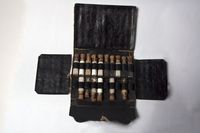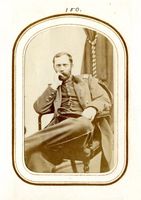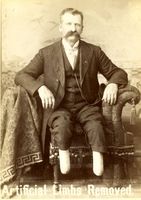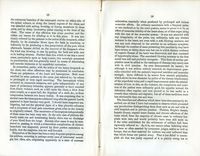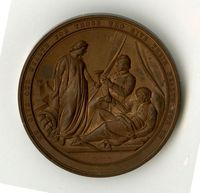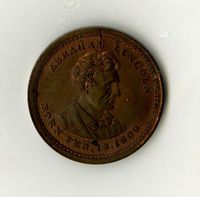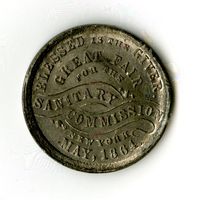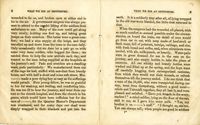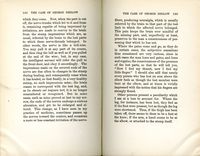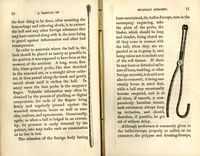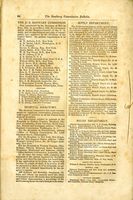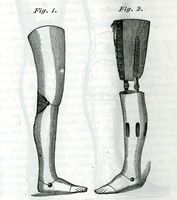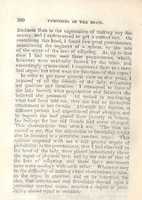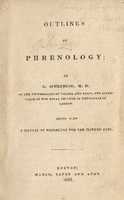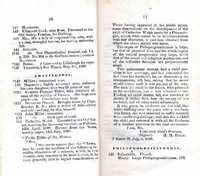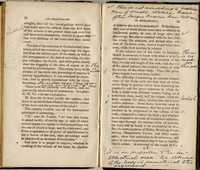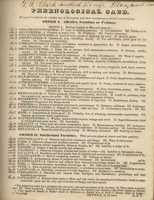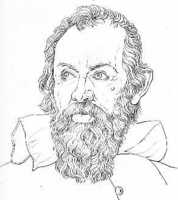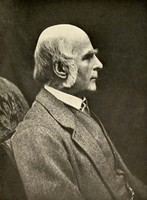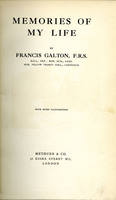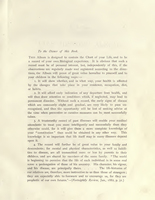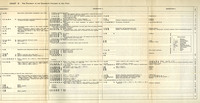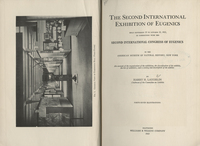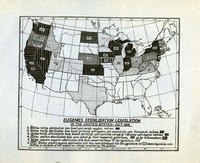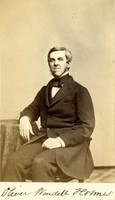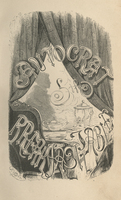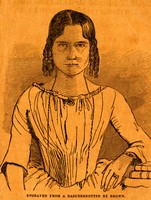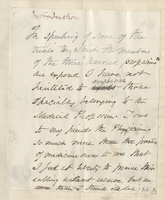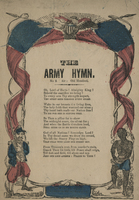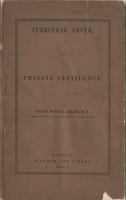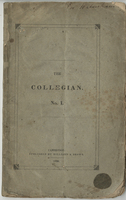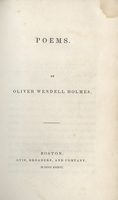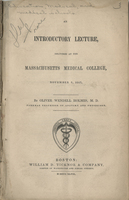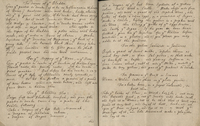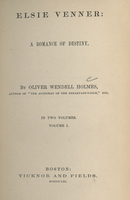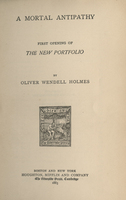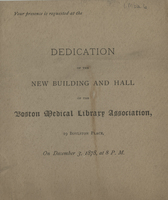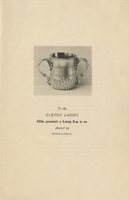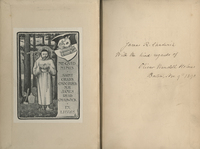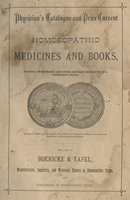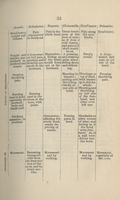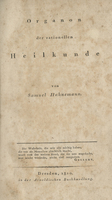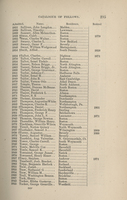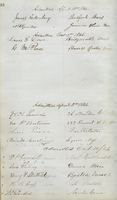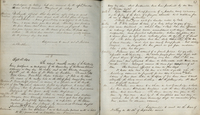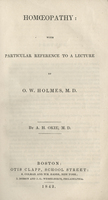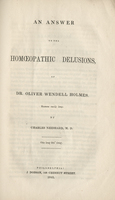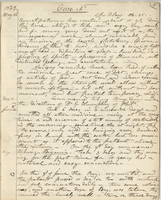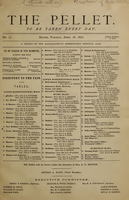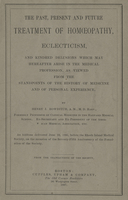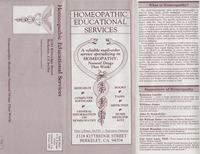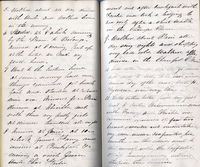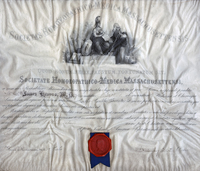Browse Items (222 total)
- Collection: Boston Medical Library
Sort by:
Illustration of the parts of the body as a house
Polish physician Tobias ben Moses Cohn knew nine languages and was court physician to five sultans in Adrianople. In 1724, he moved to Jerusalem. The Ma’aseh Tobiyyah [“Works of Tobias”] is an encyclopedia of theology, botany,…
Traveling homeopathic pharmaceutical kit
Inscription inside reads: "This medicine case is one of the articles which belonged to the late 1st Lieut. Alfred R. Glover, who was killed in battle, June 14th, 1863, at Port Hudson, La., and was afterward returned to his home."
Lucius Manlius Sargent
Lucius M. Sargent, an 1857 graduate of Harvard Medical School, was an accomplished draughtsman and was appointed the first artist of the Massachusetts General Hospital. At the beginning of the war, he became a surgeon with the 2nd Massachusetts…
Tags: Exhibit: Battle-scarred
"Artificial limbs removed"
John Wales January enlisted in Company B of the 14th Illinois Cavalry and was captured in July, 1864. The reverse of the original print of this photograph gives January's account of his sufferings as a prisoner of war and the amputation of his own…
J. M. Da Costa
Jacob M. Da Costa was a Philadelphia physician who identified a cardiac phenomenon in soldiers which he termed "irritable heart."
Tags: Exhibit: Battle-scarred
"North Western Sanitary Fair, Chicago, Ill., 1865."
Columbia to left, waving American flag. At her feet, an eagle, shield with arrows, and boxes and barrels that are marked NW, NW SV and N.W. SAN COM. The sun setting behing mountains, artillery park, and lake with ships and monitor.
Great Central Sanitary Fair at Philadelphia
Recto: "We gave our wealth for those who gave their health for us."
Verso: "In commemoration of the great central fair for the U.S. Sanitary Commission held at Philadelphia, June 1864."
Verso: "In commemoration of the great central fair for the U.S. Sanitary Commission held at Philadelphia, June 1864."
Soldiers' Fair at Springfield, Massachusetts
Recto: "Abraham Lincoln born Feb. 12, 1809."
Verso: "Soldiers' fair, Dec' 1864. Springfield, Mass."
Verso: "Soldiers' fair, Dec' 1864. Springfield, Mass."
Great fair for the Sanitary Commission held at New York.
Verso: "Blessed is the Giver. Great fair for the Sanitary Commission, New York, May, 1864."
Autograph letter signed : Baton Rouge, La., to [John Rogers, Roxbury, Mass.,?].
Alfred R. Glover's body was brought back to Massachusetts and buried in Forest Hills Cemetery. His wife, Mary Louisa Bodge Glover, died on September 10, 1864, of phthisis, though according to Henry A. Willis, historian of the 53rd Regiment, she, it…
Autograph letter signed : Washington, D.C., to [Abby Ann Newbold Cox, New York, N.Y.?]
Former professor of surgery at the New-York Medical College, Abraham L. Cox resigned his New York practice at the opening of the war and became the Surgeon-in-Chief, 1st Division, 20th Corps, of the Army of the Cumberland. "Hastened by the labor and…
"The autobiography of a quack : and the case of George Dedlow"
This tale of a Civil War soldier, George Dedlow, who loses both his arms and his legs but continues to experience sensation in his missing limbs the phantom limb phenomenon was written by Silas Weir Mitchell and grew out of his experience with…
"A manual of military surgery; or, hints on the emergencies of field, camp and hospital practice."
S. D. Gross, professor of surgery at the Jefferson Medical College in Philadelphia, was one of the country's foremost operative surgeons. He designed this brief textbook on field surgery for emergencies: portable, easy of reference, always at hand.…
"Sanitary Commission bulletin," vol. 1, no. 2.
Issued twice monthly from November, 1863, to August, 1865, the Bulletin reported on the work of the Commission and the local sanitary fairs, accounts of battles and the experiences of prisoners of war, and provided a regular means to report on the…
"Sanitary Commission bulletin," vol. 1, no. 22.
Issued twice monthly from November, 1863, to August, 1865, the Bulletin reported on the work of the Commission and the local sanitary fairs, accounts of battles and the experiences of prisoners of war, and provided a regular means to report on the…
"The Salem leg, under the patronage of the United States government for the use of the army."
The injuries and amputations of Civil War soldiers fostered a booming industry in the manufacture and marketing of artificial limbs. The Salem Leg Company—Dr. Edward Brooks Peirson was the president of its board—achieved early prominence due to its…
"The Douglass patent artificial limbs."
Douglass' advertising pamphlet for his artificial limbs makes a point that, unlike the Salem leg, "these limbs have never been dependent upon the Government for their support, but are thoroughly established on the real and intrinsic merits of the…
Tags: Exhibit: Battle-scarred
The Influence of the Brain on the Form of the Head
This English translation of Franz Joseph Gall’s Sur les Fonctions du Cerveau was one of the Boston Phrenological Society’s first publication projects. In this passage, Gall describes how he isolated the faculties of attachment and…
Outlines of Phrenology
Published while Spurzheim was touring in America, the Outlines of Phrenology was phenomenally popular, passing through four separate editions by 1834. The Outlines gives a brief overview of the theory behind phrenology, discusses the basic…
Death of Dr. Spurzheim
This unsigned obituary is one of several articles devoted to J. G. Spurzheim printed in The Boston Medical and Surgical Journal at this time. Note the prominent medical figures, including Drs. John Collins Warren, James Jackson, Walter Channing, and…
A Catalogue of Phrenological Specimens Belonging to the Boston Phrenological Society
Formed after the death of Johann Gaspar Spurzheim, the Boston Phrenological Society assembled a large collection of skulls, masks, and casts of famous and infamous heads to illustrate the various phrenological faculties.
An Examination of Phrenology
While a professor of anatomy and physiology at Columbian College in Washington, D.C., Thomas Sewall published these two lectures to students—one of the earliest attacks on phrenological doctrine—based on his study of the brain's…
Nasology, or, Hints towards a Classification of Noses
This extended joke at the expense of phrenology passed through several editions in the mid-19th century and was published under the pseudonym of Eden Warwick. George Jabet maintains that the nose, besides being an ornament to the face, or a…
Tags: Exhibit: Talking Heads, phrenology, satires
Phrenological Reading of G. H. Clark
Lorenzo Niles Fowler compiled this notebook of phrenological readings of individuals encountered during his travels through upstate New York, western Pennsylvania, Ohio, Indiana, and Kentucky in 1834 and 1835. There are a number of examinations of…
Verses Inscribed by a Phrenologist on a Skull
The variety of subjects allied to phrenology under the Fowler brothers is illustrated by this volume of their popular periodical. In addition to biographical sketches of prominent individuals, cranial analyses, and news of the progress of the…
Tags: Exhibit: Talking Heads, phrenology, Poetry
Lorenzo Niles Fowler
This short guide to phrenology by Lorenzo Niles Fowler and his daughter, defines the various faculties and concludes with an essay describing the procedure for finding certain organs on the surface of the skull. "Let us take, then, for our starting…
Phrenology: the Science of the Mind, the Student's Enchyridion
Designed for students and a testament to the enduring interest in phrenology, this manual attempts to reconcile phrenology with anatomy and "to demonstrate the possibility of the accurate localisation of the phrenological organs in the brain, upon…
Tags: Exhibit: Talking Heads, phrenology
Galileo and Bruegel from Anatomie et Physiologie du Système Nerveux
Anatomie et Physiologie du Système Nerveux is the seminal work in which Gall discusses the location of the original twenty-seven cerebral faculties and the functions of each. The first two volumes, concerning the anatomical structure of the…
Instructive and Amusing! Phrenology and Electric Psychology! Advertisement
This mid-19th century broadside advertises a course of phrenological public lectures and head readings tied to an array of subjects such as somnambulism and biology.
Tags: phrenology
Diagram of the Phrenological Faculties
An illustration of the thirty-five phrenological faculties, as seen in Samuel Roberts Wells' How to read character : a new illustrated hand-book of phrenology and physiognomy, for students and examiners : with a descriptive chart. This particular…
Sir Francis Galton
Photograph of Sir Francis Galton from his book Memories of my life. Found on the plate facing page 244.
Hereditary genius : an inquiry into its laws and consequences
Francis Galton, influenced by the work of Charles Darwin, came to believe that, following research into the biographies and genealogies of 400 famous individuals—judges, statesmen, poets, painters, scientists and athletes—genius was…
Men of Science
Francis Galton, influenced by the work of Charles Darwin, came to believe that, following research into the biographies and genealogies of 400 famous individuals—judges, statesmen, poets, painters, scientists and athletes—genius was…
Memories of My Life
At the conclusion of this autobiographical account, Galton considers the goal of his work on eugenics and its contrast to Darwinian natural selection: “Man is gifted with pity and other kindly feelings; he has also the power of preventing many…
Life History Album
Intended to chart the medical history of an individual from birth until the age of 75, the Life history album, edited by Francis Galton, allows for notes on the genealogy, life, development, marriage, children, height and weight observations,…
Composite Portraits
An arrangement of composite portraits by Henry Pickering Bowditch (1840-1911) in the publication from the second International Exhibition of Eugenics in 1921. While the composite photographs on display here as well as others in the collections of the…
Heredity : its relation to human development
In 1880, Bostonian Loring Moody, familiar with Galton’s work, issued a circular to form an Institute of Heredity, part school, part library, to promote lectures and interest in addressing social ills through eugenic principles. The circular…
Heredity in relation to eugenics
Harvard graduate, Charles Benedict Davenport, was one of the leaders of the American eugenics movement. In 1904, he became the director of the Carnegie Institution’s Station for Experimental Evolution at Cold Spring Harbor, on Long Island, and…
Fifth generation of the Juke Family
One of the first and most influential of the eugenic studies of a pseudonymous family, Richard L. Dugdale’s The Jukes traces the origins of imprisoned members of the same family back to the colonial period to examine inherited and environmental…
The Kallikak family : a study in the heredity of feeble-mindedness
Henry Herbert Goddard’s study, The Kallikak family, tracks 480 descendants of Martin Kallikak, known as the “Old Horror,” the illegitimate son of a feeble-minded girl. Among the descendants were alcoholics, prostitutes, epileptics,…
Heredity and human progress
In this radical work, Washington physician, William Duncan McKim, proposed moving beyond sterilization of the “very weak and the very vicious” to liquidation by the state through the use of carbonic acid gas. In his chapter “A…
Eugenics, genetics and the family : scientific papers of the Second International Congress of Eugenics
There were three international meetings of eugenics researchers during the period of the movement’s greatest influence and activity. This volume reprints the scientific papers from the Second Congress, held at the American Museum of Natural…
The Second International Exhibition of Eugenics
Harry Hamilton Laughlin was chairman of the Committee on Exhibits associated with the Second International Congress and organized this display at the American Museum of Natural History in the fall of 1921. A gift of $2,500 from Mrs. E. H. Harriman…
Eugenical sterilization in the United States
Harry H. Laughlin was director of Eugenics Record Office for thirty years and assisted Charles B. Davenport in first publishing the Eugenics Research Association’s Eugenical news to promote the activities of the Office. In 1922, he compiled and…
Oliver Wendell Holmes, circa 1872
The original of this photograph is preserved in an album of the members of the Boston Society for Medical Improvement, compiled in 1872. Holmes was elected to membership in the society in 1836, just after his graduation from Harvard Medical School.
The autocrat of the breakfast-table
Beyond the sphere of poetry, the literary reputation of Oliver Wendell Holmes rests largely on the loosely connected series of essays, poems, and aphorisms which forms The autocrat of the breakfast-table. The essays were originally printed in issues…
Sarah H. Furber
In 1848, after millworker Sarah H. Furber died following an abortion, physician John McNab (1783-1878) brought her body to Boston and offered to sell it to Holmes as a subject for dissection at the Medical School. The offer was refused, but Holmes…
Nautilus bookplate
On January 23, 1889, Oliver Wendell Holmes presented his book collection of over 900 volumes to the Boston Medical Library, with holdings ranging over four centuries, from the most current publications back to the beginnings of printing. A copy of…
Harvard Medical School in 1883
During the 1880s, Holmes was involved with the fund-raising appeals for the Medical School’s Boylston Street building. As part of the centennial celebration and dedication of the new building in 1883, he delivered this oration, tracing the…
Poem at the centennial anniversary dinner
of the Massachusetts Medical Society
Holmes recited this poem at the anniversary celebration of the Society, held on June 8, 1881, and it was subsequently printed in the Boston medical and surgical journal. The poem contrasts the fortunes of priests, lawyers, and physicians but “I…
My hunt after 'The Captain'
Oliver Wendell Holmes, Jr., abandoned his studies at Harvard College to join the Massachusetts Volunteers at the outbreak of the Civil War. He was wounded on October 21, 1861, at the battle of Ball’s Bluff, in Virginia, and attended by a…
The army hymn
This patriotic musical poem was first printed in the June issue of The Atlantic monthly and also as part of a program for a prize-giving ceremony at the Boston Latin School on May 25, 1861, just a few weeks after Confederate forces began firing on…
Puerperal fever, as a private pestilence
There was a great deal of initial resistance and hostility to Holmes’ ideas, particularly from two noted Philadelphia obstetricians, Charles D. Meigs and Hugh Lenox Hodge. In 1855, a reprint of the article appeared as Puerperal fever, as a…
Minute book
During the summer of 1842, the Boston Society for Medical Improvement, a scientific organization of which Holmes and many of his friends from his European sojourn were members, began to consider the question of puerperal fever. Following reports of…
The collegian, no. I
The first published poems of Oliver Wendell Holmes were printed in the six issues of a monthly Harvard undergraduate student magazine, The collegian, from February through July, 1830. Some of his poems then appeared in Illustrations of the…
Poems
In addition to The collegian, some of Oliver Wendell Holmes's (1809-1894) poems then appeared in Illustrations of the Athenæum gallery of paintings (1830) and The harbinger : a may-gift (1833). Holmes’ Poems (1836) represents the first…
An introductory lecture, delivered at the Massachusetts Medical College
Holmes assumed the professorship of anatomy and physiology at Harvard in the fall of 1847 and delivered this introductory lecture to the students on November 3. In an overview of the medical developments of Boston, Holmes alludes here to “the…
Receipts to cure various disorders for my worthy friend, Mr. Winthrop
English physician Edward Stafford compiled this book of basic recipes for medical disorders such as madness, vertigo, and the king’s evil for John Winthrop (1588-1649), the governor of Massachusetts.
Elsie Venner : a romance of destiny
First edition of Holmes' novel, Elsie Venner. This is a presentation copy from Holmes to Henry Jacob Bigelow (1818-1890). After Holmes’ death, his friend and fellow novelist William Dean Howells (1837-1920) said of Holmes' work, “His…
The guardian angel
First edition of Holmes' novel, The Guardian Angel. After Holmes’ death, his friend and fellow novelist William Dean Howells (1837-1920) said of Holmes' work, “His novels all belonged to an order of romance which was as distinctly his own…
A mortal antipathy : first opening of the new portfolio
First edition of Holmes' novel, A mortal antipathy : first opening of the new portfolio. After Holmes’ death, his friend and fellow novelist William Dean Howells (1837-1920) said of Holmes' work, “His novels all belonged to an order of…
Trials of a public benefactor, as illustrated in the discovery of etherization
Commissioned by William T. G. Morton, Trials of a public benefactor attempts to provide support for his claim to precedence in the discovery of ether anesthesia. Here, as part of the story, Oliver Wendell Holmes coins the term in a letter to Morton…
Dedication of the new building and hall of the Boston Medical Library Association
Following the formation of the Boston Medical Library in 1875, Holmes agreed to be the Association’s first president. He delivered the dedicatory address at the opening of the library’s new building at 19 Boylston Place in 1878 and here…
A dissertation on acute pericarditis
This is the manuscript of Holmes' thesis, submitted as part of the degree requirements at Harvard Medical School. Following his return from his sojourn in Europe, he compiled the thesis from lectures of Pierre Charles Alexandre Louis he had attended…
1836 Boylston Prize Dissertations
After receiving his medical degree from Harvard, Holmes was granted the Boylston Prize in 1836 for his essay responding to the question “How far are the external means of exploring the condition of internal organs to be considered useful and…
To the eleven ladies who presented a loving cup to me
Holmes responded to the gift of the cup with a poem, “To the eleven ladies who presented me with a loving cup.” The poem was first printed privately, in just twelve copies; each was signed by Holmes and copies sent to his eleven admirers.…
Over the teacups
The poem "To the eleven ladies who presented me with a loving cup" was reprinted in Over the teacups (1891), Holmes’ late collection of essays and poems following in the vein of The autocrat of the breakfast-table. This copy of the first…
Facsimile telegram
Following Holmes’ resignation of his professorship at Harvard, the physicians of New York hosted a public dinner in his honor. Each guest was given a mock telegram from “The American Rabid Telegraph Company,” quoting lines from…
Homeopathic physician's catalogue
1880 physician's catalogue and price current of homœopathic medicines and books, surgical instruments, and other articles pertaining to a physician's outfit for sale by Boericke & Tafel
Domestic homœopathy
This popular homeopathic text for use in the home went through five editions in both London and Boston, where it was printed by Otis Clapp. Inside, there is information on obtaining medicine from "James Epps, Homœopathic Chemist," almost…
Organon der rationellen Heilkunde
The Organon is Samuel Hahnemann's statement of the theory behind homeopathy and a fundamental text of the new movement. It went through five different editions during Hahnemann's lifetime and was widely translated; new editions and translations…
Organon of the art of healing
The fifth edition of Hahnemann's Organon was translated into English by Conrad Wesselhoeft of Boston. It is clear from his introduction, however, that while still critical of allopathic practice, Wesselhoeft was not a homeopathic fundamentalist:…
Directory of Homeopathic Physicians
As the directory entries for homeopaths in Boston testify, the number of practitioners was on the decline by the mid-1920s, with only 126 listed. Roughly one in every five of these physicians was female. This is just a small fraction of the over…
Catalogue of fellows of the Massachusetts Medical Society
Printed as part of the published proceedings of the Society, this list of fellows from 1872 is the last to include homeopathic members such as Israel Tisdale Talbot, David Thayer, and Herman L. H. Hoffendahl, prior to their expulsion in June 1873.…
Ballot to dissolve the Massachusetts Homeopathic Medical Society
On April 15, 1964, at the 124th annual meeting, the members of the Massachusetts Homeopathic Medical Society voted 10-5 to dissolve their organization.
Signatures of the new members of the Massachusetts Homeopathic Medical Society
Following the reorganization of the Medical Fraternity as the Medical Society, the members used this volume to record changes in the by-laws. New members added their signatures upon admission to the society through 1881.
Minute Book of the Massachusetts Homeopathic Fraternity
Formed by Samuel Gregg and a handful of other pioneer practitioners, the Massachusetts Homeopathic Fraternity met monthly at the homes of its members to discuss cases and exchange information. It came to have over eighty members and eventually…
Homœopathy : with particular reference to a lecture by O. W. Holmes, M.D.
Pamphlet printed in reaction to the Oliver Wendell Holmes (1809-1894) lecture on homeopathy.
An answer to the homœopathic delusions, of Dr. Oliver Wendell Holmes
This is one of the pamphlets printed in reaction to the Holmes lecture on homeopathy. In responding to Holmes' criticism of the use of infinitesimal doses, Charles Neidhard states, "We, with many Homœopathic physicians, have never believed in…
A lecture on homœopathy before the members
of the Boylston Medical Society
In contrast to the bitter controversies of the previous decade, the 1880s saw the distinct medical factions in Boston making tentative overtures to one another. In April 1886, Dr. Vincent Y. Bowditch, president of Harvard's Boylston Medical Society,…
Cases treated according to homœopathic principles
The second homeopathic practitioner in Massachusetts and the first to practice in Boston, Dr. Josiah Foster Flagg became convinced of the efficacy of homeopathy after obtaining relief from chronic dyspepsia. This case book, listing patients treated…
Homœopathy simplified; or, domestic practice made easy
This popular manual of domestic homeopathic practice—dedicated to Samuel Gregg—went through five editions. Its author, John A. Tarbell, also published the Pocket homœopathist and edited the Quarterly homœopathic review and…
The Pellet
During the Massachusetts Homoeopathic Hospital Fair, this newsletter of anecdotes and poetry, The Pellet, was printed and sold each day. The Fair itself raised $72,000 and prompted the formation of the homeopathic medical school at Boston University.
Tags: Exhibit: Grand Delusion, homeopathy, Poetry
The past, present and future treatment of homœopathy
H. I. Bowditch was the sole dissenting voice in the vote to expel homeopaths from the Massachusetts Medical Society in 1871. "By the sympathies excited among the laity, by our worse than foolish persecutions, we have built up their sectarian schools…
Catalogue of homoeopathic books
A catalogue of homeopathic books and other items for sale by Otis Clapp.
Homeopathic Educational Services Flyer
This mail order supply house in California markets homeopathic books, tapes and DVDs, software, and home medicine kits. The firm's motto is "Homeopathic medicines: natural drugs that work," and it promotes homeopathy as "a 21st century science since…
Diary of a man seeking care under Samuel Hahnemann
After a course of cupping, blistering, and taking the waters at the German spa of Wiesbaden, the unnamed subject of this diary sought relief from his rheumatism by coming under the care of Samuel Hahnemann in Paris in 1838.
Hahnemann Society membership certificate
The Hahnemann Society was an honorary students' society at Boston University, organized in 1880. Dr. James Krauss (1866-1939) received his medical degree magna cum laude in 1889 and practiced in Boston, specializing in genito-urinary medicine and…
Massachusetts Homeopathic Medical Society fellowship certificate
Dr. James Krauss (1866-1939) received his medical degree magna cum laude in 1889 and practiced in Boston, specializing in genito-urinary medicine and surgery


